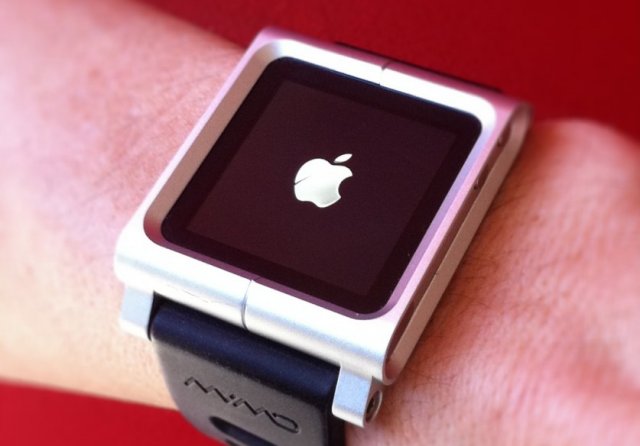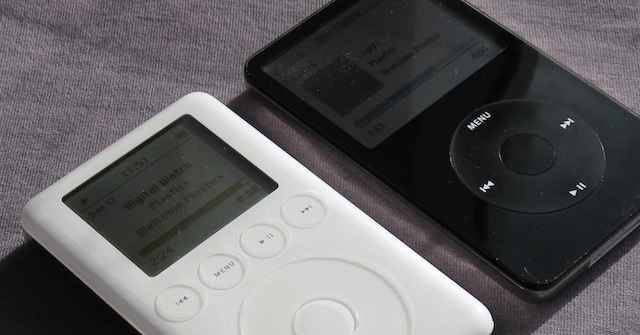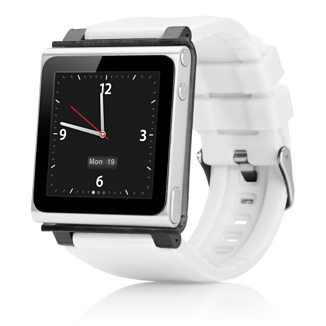
A Kickstarter project made watch bands for the iPod nano, but Apple would likely deviate from this design.
Way back when I was a young nerd, the first electronic gadget I owned was a digital LED watch. These were the first digital watches from before the rise of LCD displays. You had to press a button to make the time light up in the form of menacingly red digits—having the time displayed continuously would have taken too much power. Several LCD watches followed during the 1980s, but my watch-wearing days came to an abrupt end when I got my first cell phone.
However, with the advent of the Pebble smart watch and all the iWatch rumors, I can see myself wearing a watch again in the near future. Maybe not all day every day, but certainly when on the go, so I can keep my iPhone tucked away safely but still interact with my digital life.
But what would a smart watch built by Apple be like? Time to put on our speculation spectacles.
Radios
First of all, the iWatch is unlikely to have 4G support. Or 3G. Or any G. Why? An iPhone 5 with its 1434 milliampere-hours (mAh) battery can handle standby times of "up to" 9 days—if you let the phone lie on your night stand without touching it, that is. The Pebble watch has a battery about a tenth the size of the iPhone's, so that would make for about a day's worth of 3G standby time. A cellular connection just takes too much power. It's not going to happen. A 3G iWatch would also be more expensive to build and use. (Yay, another data plan!)
Wi-Fi is not impossible, but it's unlikely—dealing with different Wi-Fi networks and intermittent connectivity is just too onerous. Without the need to transfer big files, Bluetooth is fast enough and much more energy efficient, especially Bluetooth 4.0, which Apple has conveniently been building into its recent Macs and iOS devices. Bluetooth also works directly from device to device without a need for Wi-Fi base stations.
Without its own connection to the Internet, the iWatch won't be able to do very much by itself. Like the Pebble watch, it will undoubtedly be an accessory for the iPhone. It may be an accessory for other devices in the Apple ecosystem, such as iPods, iPads, Macs, and Apple TVs. No need to limit the market for the iWatch to just iPhone users.
On the other hand, by having Wi-Fi onboard, the iWatch could operate independently from an iOS device, which would make the device much more attractive to those without iPhones, such as kids.
Power
Many people feel that the need to charge a watch frequently would make an iWatch a non-starter. Yes, this is certainly a downside, but I'm pretty sure people will live with this if the features are compelling. Several days to a week of battery life seems a reasonable tradeoff. However, it would be great if Apple could incorporate a battery that can be topped off quickly, perhaps by usingsupercapacitor technology. A supercapacitor doesn't hold nearly as much energy as a battery, but it has the advantage that it can be charged in seconds.
I'm not sure whether Apple would reuse the Lighting connector, use something MagSafe-like that allows for charging while wearing the watch, or adopt some form of wireless charging. Each solution has pros and cons.
The Pebble only has Bluetooth connectivity and a black-and-white LCD screen (although the company calls it e-paper); its 150 mAh battery that lasts seven days with regular use is charged using a connector not unlike a MagSafe one.
Display
Although it's unlikely that an iWatch would play video or fast-moving games, a responsive display is still needed to allow the contents of the screen to track finger movements and play other animations. As such, the display would very likely be LCD-based rather than use e-ink or another non-LCD display technology. OLEDs also don't seem like a viable option, because they need to actively emit light to be visible. They can do this pretty efficiently in dim environments, but OLEDs still use too much power in bright sunlight.
Maybe Apple's hardware magicians can figure out a way around this, but I don't see how the screen could be a regular color LCD display. Although the light has to pass through a polarizer twice in a monochrome LCD display, those displays can be made bright enough to be useful without a backlight. With color LCD displays this is much harder, because now there are also color filters in the way, further reducing the ambient light that can be reflected back.

The iPod 3G and iPod 5G with unbacklit screens.
The third-generation iPod uses a black-and-white LCD display, and it only turns on the backlight when the user presses the right button. The fifth-generation iPod has a color LCD display that stays on during audio playback, but as soon as you interact with the device, it turns on the backlight. With the backlight off, the screen has very little contrast—sometimes enough to be useful, sometimes not. The iPhone doesn't even bother keeping the display on when the backlight is off. As I found out wearing that LED watch, needing both hands to see what time it is gets old fast.
It's possible that Apple would opt to automatically turn on the backlight for a color LCD display based on sensed arm movements. However, I'm not sure that can be made sufficiently reliable. Also, having a display that's always on so it can always display the current status of the world seems like a perfect complement to the iPhone, which goes dark after a minute or two when unused.
However, this is not to say that the iWatch's display can't be colorful. Apple could steal borrow be inspired by the Philips Hue LED lights and have RGB LEDs for the backlight, allowing the backlight to take on any color desired.
If the LCD screen has a sufficiently fast response time, it would even be possible cycle through red, green, and blue backlit images in quick succession to produce a color image, similar to how DLP projectors operate.

If the display is indeed based a monochrome LCD, it could support reading of linear barcodes and thus make Passbook a whole lot more useful. Linear barcodes are usually read by scanning them with a laser and then determining how much laser light reflects back. Color LCDs don't reflect much light, but they emit their own, and thus linear barcodes on a color LCD screen can't be read by most scanners.
Looking at Lennart Ziburski's concept of a smart watch, I am struck by the circular display that he uses in his post. This is exactly the kind of risky design and manufacturing choice that Apple could and would make, embracing style over pedestrian considerations such as ease of manufacturing.
User interface
Zuburski suggests a scroll wheel/ring around the display for navigation. I don't see that happening. Scroll wheels are great on largish iPods, because they allow for easy one-thumbed operation, with the fingers of the same hand holding the device. With a watch, finer movements are harder, because your right hand and left wrist can easily move relative to each other unintentionally.
So it's important that most interaction with the iWatch work without requiring too much precision. For instance, it could work by allowing users to swipe and tap a touchscreen with one or two fingers. The addition of double tapping would allow for about a dozen different gestures, which should be sufficient to control the iWatch's most commonly used functions and switch between them. For less common functions, a number pad taking up pretty much the entire touchscreen is probably the limit for such a small device—unless you want to use a stylus. Add a home button for iOS-like familiarity and to get the iWatch unstuck when it gets confused.
The iWatch could have a microphone to talk to Siri, but remember that Siri actually lives in Apple's data centers, so Siri-powered functionality would have to be funneled through an iPhone or other iOS device. I doubt that Siri would speak back through the iWatch; that would require a relatively good (and thus large) speaker, it could possibly use too much power, and it would be disruptive to others. The watch is right in front of you when you talk to it, so it's easy enough to look at the screen. But if you're wearing headphones connected to your iPhone, Siri could talk back.
The iWatch would of course vibrate when notifications come in—preferably silently. Bruce "Tog" Tognazzini (developer of the original Apple Human Interface Guidelines in 1978) speculates that the iWatch may spur a Morse code renaissance among kids, allowing them to message each other during class with impunity. Hey, stranger things have happened.
What the rumored Apple iWatch might look like, inside and out
We speculate on the properties of a rumored Apple "iWatch."
Functions and apps

Of course the iWatch will tell time. It will undoubtedly have a selection of beautifully designed watch faces, and it will possibly allow third-party watch faces to be installed. However, it seems doubtful that the iWatch will run apps in iOS-like fashion. Despite Apple's best efforts, iOS is still a pretty resource-intensive operating system, and many of those resources are taken up by the security mechanisms needed to run third-party apps safely. It's more likely that apps running on an iPhone, iPod touch, or iPad—possibly a Mac—get to use a Bluetooth-connected iWatch's screen for output and its sensors for input.
As shown by the Pebble watch, iOS is already capable of forwarding notifications to a smart watch over Bluetooth. This is the killer app for a smart watch, and it will be exciting to see how this function will evolve. Buzzing, turning on the backlight and showing the sender and a few words from a text message or e-mail is useful, but that's just the beginning. Quickly triaging those into "remind me later," "delete," and "mark as read" would be immensely helpful.
I'm also looking forward to controlling audio playback from my wrist. Maybe I'm expecting too much from this, though: when operating a vehicle with a steering wheel—which would be most of them—you can't really operate watch-based controls very well. It's hard to say what this would mean for road safety. Yes, glancing at your watch to look at incoming notifications while driving is disruptive, but it should be quicker and easier than taking out a phone. Also, unless that Morse code thing happens, it's hard to imagine how people would enter text messages on an iWatch while driving, so hopefully they'll refrain from trying to do so.
Maybe playback controls will be more helpful on the couch, when watching Apple TV content. The iWatch could show time passed and time remaining for the current movie or TV show and let you pause and resume playback with one tap. And of course, it could pause playback when you get a call. But now that we know that the Apple TV has Bluetooth on board, the iPhone and Apple TV should be able to make that happen without an iWatch, too.
I was surprised to find out that an iPod shuffle only has a 51 mAh battery, which still allows for 15 hours of audio playback. So a watch-sized device could easily play audio. However, it's likely that Apple will prefer to sell you a separate device for that, and hooking up headphones to a wrist watch also seems less than ideal.
In his iWatch post, Tognazzini describes how an iWatch could be used to lock and unlock access to your Mac using Bluetooth proximity detection. The iWatch could even sense when you've taken it off and then require re-authentication afterwards. Tognazzini also thinks a watch is a much better place for an NFC chip used for payments, and an iWatch could be used to find your iPhone easily or even warn you when you're leaving the house without taking your iPhone with you—perish the thought.

The iWatch could display a miniature version of Apple's maps for the purpose of walking directions. In this case, it would be very helpful to have an electronic compass on board to make the map view line up with the environment even if you don't hold your wrist exactly perpendicular to your direction of travel.
Although in regular use, the iWatch would provide access to the iOS calendars, contacts, and notes through its Bluetooth connection, I still think the iWatch should have its own copy of those. This way, you could still have access to your notes, get notified of your appointments, and call everyone you know if your iPhone runs out of juice... or gets lost or stolen. Bonus points if the iWatch can beep out phone numbers as DTMF tones in case you need to use a land line and transmit them over Bluetooth to other people's cell phones.
Last but not least, a smart watch is in a very good position to monitor your movements, similar to afitbit. It could also monitor your pulse, although this may use too much power to do continuously. Still, an iWatch could be an excellent fitness companion. Then again, Apple may prefer to sell separate devices for this.
Size and shape
A watch is as much a fashion accessory as it is time keeping tool—or a multi-purpose gadget. As such, one problem that Apple faces is to get people who have different watches for different occasions to wear the iWatch every day. A solution would be to separate the gadget from the housing and the strap, so fashionistas can switch out different designs without buying numerous iWatch devices. I'm sure third-party manufacturers would love the opportunity to enter that market. But according to Ariel Adams over at A Blog to Watch, "Apple will benefit from producing much more conservative looking iWatches so as to appeal to a wider audience." That sounds about right. Apple may investigate more complex options if the iWatch is a success.
The reported curved glass makes sense, Apple loves smooth curves and shiny surfaces. On the other hand, unusual shapes make it harder to fit the insides, and curved glass could easily be a reflective nightmare. And glass breaks easily. Hopefully, the flexible glass rumors are incorrect, because I can't see how that would be anything other than a train wreck: not only would you have to hold the iWatch just right to avoid reflections, you'd also have to be careful using it or it flexes. No thanks.
I'm guessing Apple would stay away from too much chrome and steel, and rather use black, so I wouldn't count out anodized aluminum just yet. Maybe they'll release a white one a year later. The strap should be user-replaceable—unless there are sensors or an NFC antenna in the strap.
As for size of the watch face, 2" (51mm) seems about the upper limit of what's reasonable for a watch on my (big) wrist. Something like 1.3" to 1.5" (33mm to 38mm) would probably work well as a screen size. This should be sufficiently big to accommodate two-finger swipes. The Pebble's screen is 1.26" (32mm). This is of course still pretty clunky compared to most regular watches. But hey, those don't talk to your iOS devices over Bluetooth.
What's in a name?
Dave Caolo asks if "watch" is the wrong word. Just because you wear it on your wrist and one of the many things it can do is tell you the time, doesn't make it a watch. In that sense, "iPhone" is also an incorrect name. Clayton Christensen, author of the famous business book The Innovator's Dilemma, pooh-poohed the iPhone, because it didn't really do anything to disrupt the cell phone. Only later did he realize that the iPhone is really a smaller, cheaper computer, which also happens to make phone calls, rather than just a phone. (The fact that Apple only started to support third-party apps on the iPhone after jailbreakers had shown it could be done makes me think Apple also didn't really knowwhat they had on their hands from day one.)
So far I've been using the name "iWatch" as if that name is a given, but clearly that's not something we know yet. But if Apple can choose the name "iPhone" while another company holds the trademarkand fly in the face of mockery with "iPad," I'm certainly not betting against "iWatch."
No comments:
Post a Comment
Let us know your Thoughts and ideas!
Your comment will be deleted if you
Spam , Adv. Or use of bad language!
Try not to! And thank for visiting and for the comment
Keep visiting and spread and share our post !!
Sharing is a kind way of caring!! Thanks again!